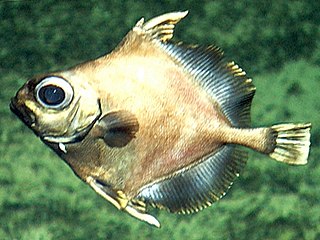Ophidiiformes is an order of ray-finned fish that includes the cusk-eels, pearlfishes, viviparous brotulas, and others. Members of this order have small heads and long slender bodies. They have either smooth scales or no scales, a long dorsal fin and an anal fin that typically runs into the caudal fin. They mostly come from the tropics and subtropics, and live in both freshwater and marine habitats, including abyssal depths. They have adopted a range of feeding methods and lifestyles, including parasitism. The majority are egg-laying, but some are viviparous.

Brotula barbata, commonly known as the bearded brotula, Atlantic bearded brotula, or sugarfish, is a species of cusk-eel in the genus Brotula. It lives in the Atlantic Ocean, in depths of up to 300 meters. Its coloring ranges from olive-brown to red-brown, and it grows up to be around 50 centimeters. It has a carnivorous diet, and it is oviparous.

The blonde ray or blonde skate is a species of ray fish in the family Rajidae.
The Jeffrey's goby is a species of goby fish.

Chaenophryne longiceps, commonly known as the can-opener smoothdream, longhead dreamer or smooth-head dreamer, is a species of anglerfish in the family Oneirodidae (dreamers).

Scopelogadus beanii, or Bean's bigscale, is a species of ridgehead fish. It is named for Tarleton Hoffman Bean.
The smallmouth spiny eel, also called the shortspine tapirfish, is a species of deep-sea spiny eel.

The false boarfish is a species of fish in the family Oreosomatidae (oreos).

Sigmops bathyphilus, commonly called the spark anglemouth, deepsea fangjaw or deepsea lightfish, is a species of fish in the family Gonostomatidae (anglemouths).
Cataetyx laticeps is a species of fish in the family Bythitidae.

Cataetyx alleni, sometimes called Allen's brotula, is a species of fish in the family Bythitidae.
The large-eye snaggletooth, also called the straightline dragonfish or Antarctic snaggletooth, is a species of fish in the family Stomiidae.

The North Atlantic codling is a species of fish in the family Moridae.

The rendezvous fish is a species of fish in the family Phosichthyidae (lightfish).
The salmon smooth-head, also called the deepsea slickhead, is a species of fish in the family Alepocephalidae.
Polymetme thaeocoryla is a species of fish in the family Phosichthyidae (lightfish).
Nansenia oblita, also called the forgotten argentine or the Mediterranean large-eyed argentine, is a species of fish in the pencil smelt family (Microstomatidae).

Cocco's lantern fish, also called Gemellar's lanternfish, is a species of lanternfish.
Leptostomias gladiator is a species of fish in the family Stomiidae. It is sometimes called the scaleless dragonfish, but that name is shared with many other species.
The glasshead grenadier is a species of fish in the family Macrouridae.










